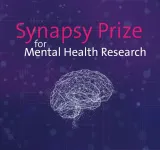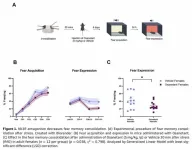(Press-News.org) Peer-reviewed/ Review, Analysis and Opinion / People
The Lancet: Nearly 500,000 children could die from AIDS-related causes by 2030 without stable PEPFAR programmes, expert policy analysis estimates
Experts assessed the potential impacts on HIV/AIDS treatment and prevention efforts in sub-Saharan Africa if the US President’s Emergency Plan for AIDS Relief (PEPFAR) is suspended or only receives limited, short-term funding, estimating that 1 million additional children could become infected with HIV and nearly 500,000 children could die from AIDS by 2030.
The authors also estimate that as many as 2.8 million children could become orphaned in the next five years if PEPFAR programmes are reduced or eliminated.
The analysis included an overview of PEPFAR programme benefits, including its success in increasing two-way trade between the USA and countries in Africa, improving diplomatic relations, and strengthening health systems and other programmes to support child health and prevent sexual violence against girls.
The authors call for a strategic, five-year transition plan for PEPFAR programmes to avoid preventable new paediatric HIV infections, deaths, and HIV-related orphanhood and to preserve the USA’s position as a leader in global health diplomacy.
An accompanying Correspondence letter from 11 senior health officials in Africa details commitments from national governments to transition to long-term, sustainable country ownership of HIV programmes in partnership with the USA.
In the face of ongoing funding disruptions to US foreign assistance programmes, a group of international experts calls for urgent action to ensure the continuation of life-saving interventions and support for children and families affected by HIV/AIDS in sub-Saharan Africa. The new Health Policy analysis, published in The Lancet, estimates that 1 million children could become infected with HIV, nearly half a million could die from AIDS by 2030, and 2.8 million children could experience orphanhood in the region without consistent, stable funding for US President’s Emergency Plan for AIDS Relief (PEPFAR) programmes.
The authors say their analysis presents strong evidence that funding PEPFAR programmes for at least five more years is critically important to prevent unnecessary paediatric illness, death, and orphanhood, maintain current progress in efforts to prevent new HIV infections worldwide, and uphold the USA’s position as a leader in global health diplomacy.
PEPFAR, established by the United States Government in 2003, has been a cornerstone in addressing the global HIV/AIDS epidemic, providing over $120 billion in funding to treat and prevent HIV/AIDS. The programme is estimated to have saved more than 26 million lives and ensured 7.8 million babies were born HIV-free. It currently supports over 20 million people with HIV prevention and treatment services, primarily in sub-Saharan Africa [1]. However, continued funding of PEPFAR programmes remains uncertain, raising concerns about the future of HIV/AIDS prevention and treatment efforts, particularly in light of US President Trump’s executive order [2] pausing all foreign aid for 90 days pending a review. Despite PEPFAR receiving a limited waiver to continue some programmes, many of PEPFAR’s services have been disrupted or suspended since 20 January 2025. [3]
“The future of PEPFAR programmes hang in the balance. Losing stable, long-term support for PEPFAR programmes sets global progress to end HIV/AIDS back to the dark ages of the epidemic, especially for children and adolescents,” said co-lead author Prof Lucie Cluver of the University of Oxford (UK).“A sudden withdrawal of PEPFAR programmes, especially in the absence of a long term strategy to replace them, could lead to a resurgence of HIV infections and preventable deaths, and a dramatic rise in the number of children orphaned by AIDS in the coming years – a setback that could erode two decades of progress.”
Cluver adds, “Continued investments in PEPFAR programmes combined with progressive growth in African co-financing can create a sustainable transition for country-led ownership of HIV programmes and preserve the legacy of PEPFAR’s lifesaving work.”
The authors conducted an original modelled analysis using existing data [4] to predict the risks children in sub-Saharan Africa would face in the absence of PEPFAR programmes, including increased HIV infections, AIDS-related deaths, and orphanhood. The estimates suggest that by 2030, there could be 1 million new cases of paediatric HIV and 460,000 additional AIDS-related deaths in children. Furthermore, if there is a complete cessation of PEPFAR, it could substantially reduce adult life expectancies, and leaving 2.8 million additional children orphaned.
“We are already seeing the devastating impacts of the USA’s recent foreign aid freezes,” said co-author Susan Hillis, Imperial College, London (UK). “By eliminating many programmes PEPFAR supports for children beyond HIV treatment and prevention, such as programmes that prevent sexual violence and support general child health and wellbeing, many of the children and adolescents who currently benefit from PEPFAR programmes will slip through the cracks -- increasing their chances of acquiring HIV or leading to further transmission, ultimately resulting in many preventable HIV infections and deaths.”
The authors also highlight how PEPFAR programmes have demonstrated long-term sustainability by reducing children's lifetime risk of acquiring HIV. Prior to the widespread availability of antiretrovirals in Africa, more than 20 million people died from AIDS-related causes in the region, leaving behind millions of orphaned children. PEPFAR's efforts have significantly contributed to decreasing the number of AIDS orphans from its peak of over 14 million children in 2010 to 10.5 million by 2023 [5].
In addition to modelling the immediate effects of PEPFAR funding disruptions, the authors assessed PEPFAR’s impact beyond HIV/AIDS, highlighting the international diplomacy, economic benefits – including a four-fold increase in two-way trade between the USA and countries in Africa, educational improvements, and healthcare advancements, as well as various initiatives to combat violence against girls and protect vulnerable children.
“Renewing PEPFAR investments safeguards the health and well-being of millions of people and reinforces the USA's position as a global leader in foreign assistance and health diplomacy. Programmes like PEPFAR have successfully elevated public opinion of the USA and enabled bilateral cooperation not only with countries receiving PEPFAR support, but also globally, which in turn contributes to protecting national security, strengthening trade, and advancing strategic diplomacy. Ending PEPFAR would create a void likely filled by other countries, with reports indicating China and Iran are poised to assume global health leadership roles, enabling them to increase their influence in the region,” said co-lead author Gibstar Makangila, Executive Director of Circle of Hope (Zambia).
The authors also offer insights into how to build more sustainable PEPFAR programmes into 2030 and beyond, citing ongoing efforts to unite both international and local partners to close funding gaps, increase country- and community-led initiatives, and support improvements to domestic healthcare systems. PEPFAR-supported countries in Africa have already demonstrated commitments to ownership of HIV responses by 2030 with progressive increases in co-financing health systems from $13·1 billion per year in 2004 to $40·7 billion per year in 2021.[6]
“Our analysis not only highlights the immediate health implications of inadequate funding but also emphasises the broader socio-economic benefits of PEPFAR investments and offers a glimpse into the future of PEPFAR programmes, where long-term strategies that build local capacity to improve health and wellbeing for all is vital for global health security, especially as it's projected that in the next 25 years, half of all children and adolescents worldwide will live in Africa”, said co-author Joel-Pascal Ntwali--N’Konzi of the University of Oxford (UK).
Co-author Prof Chris Desmond, of the University of Kwazulu-Natal (South Africa) added, “What is urgently needed now is a well-planned transition to expanded country-ownership of PEPFAR programmes that will take this lifesaving work forward and offer stability and sustainability for countries that currently rely on PEPFAR support now and into the future, which in turn also benefits the USA and solidifies its position as a global leader in the effort to end HIV.”
The authors note some important limitations of this analysis, including that the international funding landscape is rapidly changing and the future of PEPFAR programmes are unknown. Additionally, this analysis used the best available data on HIV infections and death rates to develop future estimates.
In a related Correspondence, also published in The Lancet, 11 senior health officials from African countries wrote “Together, we are confident that we can achieve the goal of ending the HIV and AIDS pandemic as a global threat for our children and families, as our African nations collaborate with the USA and other international donors to continue transitioning towards strengthening and increasing domestic investments for health, and for HIV as a key priority within such investments. Together, we can end this fight and finish well, making not just the USA and Africa, but indeed the world, safer, stronger, and more prosperous.”
NOTES TO EDITORS
A full list of authors and their institutions is available in the paper.
The labels have been added to this press release as part of a project run by the Academy of Medical Sciences seeking to improve the communication of evidence. For more information, please see: http://www.sciencemediacentre.org/wp-content/uploads/2018/01/AMS-press-release-labelling-system-GUIDANCE.pdf if you have any questions or feedback, please contact The Lancet press office pressoffice@lancet.com
Quotes from Authors cannot be found in the text of the policy review, but have been supplied for the press release.
[1] https://www.state.gov/results-and-impact-pepfar
[2] https://www.whitehouse.gov/presidential-actions/2025/01/reevaluating-and-realigning-united-states-foreign-aid/
[3] https://www.kff.org/policy-watch/the-outlook-for-pepfar-in-2025-and-beyond/#:~:text=Despite%20PEPFAR%20receiving%20a%20limited,growing%20headwinds%20in%20recent%20years
[4] Publicly available data was used from Spectrum https://www.avenirhealth.org/software-spectrum.php
and World Population Prospects https://population.un.org/dataportal/home?df=995137c4-40d6-445f-8090-7db38eee279d
[5] https://www.afro.who.int/health-topics/hivaids
[6] amfAR issue brief: Domestic Funding Contributions to Health: Comparing Changes in Domestic Financing in PEPFAR and Non-PEPFAR Supported Countries (March 2025): https://www.amfar.org/wp-content/uploads/2025/04/IB-World-Bank-Country-Analysis.pdf
END
The Lancet: Nearly 500,000 children could die from AIDS-related causes by 2030 without stable PEPFAR programmes, expert policy analysis estimates
2025-04-08
ELSE PRESS RELEASES FROM THIS DATE:
Eclipse echoes: groundbreaking study reveals surprising avian vocal patterns during solar eclipse
2025-04-08
A new study published today in Scientific Reports reveals how birds responded to the April 8, 2024, total solar eclipse across North America. The study finds bird vocalizations significantly declined only where more than 99% solar obscuration occurred. Researchers from Loggerhead Instruments, Inc. and the K. Lisa Yang Center for Conservation Bioacoustics at the Cornell Lab of Ornithology analyzed data from 344 community-based acoustic monitoring devices, called Haikuboxes, using a novel neural network approach. Unlike previous studies, ...
Mirvie announces results from largest molecular study in pregnancy and clinical validation of simple blood test to predict risk for preeclampsia months before symptoms
2025-04-08
South San Francisco, CA (April 8, 2025) - Today, Mirvie announced results of a breakthrough study published in Nature Communications, revealing new advances in the biological understanding of hypertensive disorders of pregnancy (HDP), including preeclampsia - a leading cause of maternal morbidity and mortality as well as preterm birth. Researchers used data from more than 9,000 pregnancies within the multi-center Mirvie-sponsored Miracle of Life prospective study to discover and validate RNA signatures capable of distinguishing between severe and mild hypertensive disorders of pregnancy, including preeclampsia, months before ...
Eating only during the daytime could protect people from heart risks of shift work
2025-04-08
A study led by researchers at Mass General Brigham suggests that, when it comes to cardiovascular health, food timing could be a bigger risk factor than sleep timing
Numerous studies have shown that working the night shift is associated with serious health risks, including to the heart. However, a new study from Mass General Brigham suggests that eating only during the daytime could help people avoid the health risks associated with shift work. Results are published in Nature Communications.
“Our prior research has shown that circadian misalignment – the mistiming of our behavioral cycle relative to our internal body clock – increases cardiovascular risk factors,” ...
Discovery of mitochondrial protein by researchers at Lewis Katz School of Medicine at Temple University opens path to therapeutic advances for heart and Alzheimer’s disease
2025-04-08
(Philadelphia, PA) – Calcium transport into and out of mitochondria – the powerhouses of cells – is central to cellular energy production and cell death. To maintain the balance of calcium within these powerhouses, cells rely on a protein known as the mitochondrial sodium-calcium exchanger, or NCLX. Now, in new research, scientists at the Lewis Katz School of Medicine at Temple University have discovered a novel regulator of NCLX activity, a protein called TMEM65, which helps move ...
Recognizing the bridge builders between neuroscience and psychiatry
2025-04-08
Mental health is in crisis worldwide. While the neurosciences are advancing rapidly, psychiatry still struggles to diagnose and effectively treat many disorders. The Synapsy Center for Neuroscience and Mental Health Research at the University of Geneva, Switzerland, is launching a new international prize to reward those who bring these two worlds closer together.
A new research model is needed
Depression, schizophrenia, anxiety or bipolar disorders: psychiatric illnesses affect hundreds of millions of people worldwide and are among the leading causes of disability, suffering and mortality. Yet clinical advances remain limited. Many diagnoses ...
Lactic acid bacteria can improve plant-based dairy alternatives
2025-04-08
A new study maps how specific lactic acid bacteria can enhance both the flavour and nutritional quality of plant-based dairy alternatives. The findings may have wide-reaching perspectives for the further development of sustainable foods.
Plant-based dairy alternatives – such as soy, oat, and almond drinks – are produced without animal ingredients for consumers seeking plant-based substitutes for milk and yoghurt. However, many of these products have the similar shortcomings: flavours that do not always appeal ...
Public housing smoking ban reduced heart attacks and strokes
2025-04-08
A new paper in Nicotine & Tobacco Research, published by Oxford University Press, finds that a 2018 U.S. ban on smoking in public housing led to a reduction in hospitalizations for cardiovascular problems.
Tobacco use and exposure to secondhand smoke is a leading cause of preventable death in the United States. Some 480,000 Americans die every year due to tobacco. While the prevalence of adults exposed to secondhand smoke decreased dramatically between 1988 and 2014 (from 87.5% to 25.2%), about 58 million non-smokers in the U.S. experience tobacco smoke, primarily at home. Beginning in the early 2000s, ...
Positron emission tomography in psychiatry: Dr. Romina Mizrahi maps the molecular future
2025-04-08
MONTRÉAL, Québec, Canada, 8 April 2025 – In a powerful and deeply reflective Genomic Press Interview, published in Brain Medicine, Dr. Romina Mizrahi, Professor of Psychiatry at McGill University and Principal Investigator of the CaTS (Clinical and Translational Sciences) Lab at the Douglas Research Center, charts a new path forward in psychiatric research—one that begins at the molecular level.
Harnessing the power of positron emission tomography (PET), Dr. Mizrahi’s work sheds light on the invisible workings of the human brain. Where traditional psychiatric diagnosis often relies on subjective symptom clusters, her approach integrates in-vivo imaging, ...
Post-trauma drug blocks fear response in female mice, study shows
2025-04-08
BARCELONA, Catalonia, Spain, 8 April 2025 – A new Brevia (peer-reviewed research report) published in Brain Medicine reveals that a single dose of the drug Osanetant, administered shortly after a traumatic event, significantly dampens fear expression in female mice. The findings provide strong preclinical support for using Nk3R antagonism as a sex-specific, time-sensitive intervention to reduce the risk of posttraumatic stress disorder (PTSD).
Targeting fear memory at its roots
Fear memory is a core feature of PTSD, especially when neutral cues become emotionally ...
Trees could be spying on illegal gold mining operations in the Amazon rainforest
2025-04-08
For hundreds of years, the Amazon has been exploited for its gold. Today, the precious metal is just as sought after, but the remaining tiny gold particles are much harder to find. Mining often happens in artisanal and small-scale mining operations that release mercury (Hg) into the air, polluting the environment and harming human health.
An international team of researchers has now examined tree rings of species native to the Peruvian Amazon to determine if trees could be used to show approximately where and when atmospheric mercury was released.
“We show that Ficus insipda tree cores can be used as a biomonitor for characterizing ...





